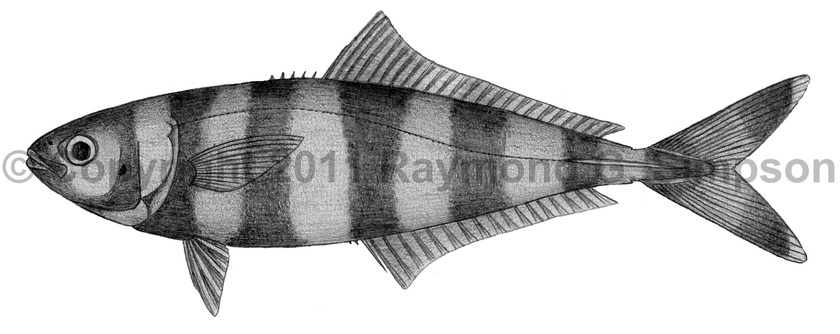
Common Name
Pilotfish
Year Described
Linnaeus, 1758
Identification
Dorsal Fin: 4-5 spines in first lobe (first or last often reduced in fish <20cm), followed by I, 25-29
Anal Fin: 2 spines separate from rest (first minute and often embedded), followed by I, 15-17
Pelvic Fin: I, 5
Gill Rakers: 6-7 upper, 15-20 lower; 21-27 total
Vertebrae: 10 precaudal, 15 caudal
Elongate and slightly compressed, with a large head, blunt snout, and small eye. Jaw does reaches anterior margin of eye. Teeth blunt, usually in a single band in both jaws. Pectoral fins shorter than head. Anterior lobe of soft dorsal raised. Anterior lobe of anal fin also slightly raised, and anal fin base is shorter than the dorsal base. Tail deeply forked. Lateral line with curved anterior portion and straight posterior portion with no scutes. Very small ctenoid scales on entire body. Caudal fleshy keel and dorsal/ventral grooves present on cuadal peduncle.
Color
Light silvery with 6 black body bands. The first is on the opercle and forms a "V" dorsally, connecting to posterior eye. The second band runs under the pectoral fin and the third from the spinous dorsal fin to the belly. The final 3 bands run onto the soft dorsal and anal fins. A seventh band is on the caudal peduncle and median caudal fin. A separate black band is found on each caudal lobe. The snout is dusky. Dorsal, anal, and pelvic fins dark, with white tips on the dorsal and anal lobes. Tips of caudal lobes white. Fish can change color to all silvery with obscured dark bands. Juveniles with bolder color pattern.
Size
Common to 35cm FL. Maximum size to 70cm TL.
Habitat
Pelagic in the open ocean, not commonly found in nearshore environments unless associated with larger fish or objects. This species is commensal with large bony fish, sharks, rays, turtles, and marine mammals, and also associates with floating debris and ships. Juveniles are also found in the open ocean.
Range
Almost the entire region: from Nova Scotia to Argentina, including all oceanic waters and islands.
References
Smith-Vaniz, W.F. 2003. Carangidae (pp 1426-1468). In: Carpenter. 2003. The living marine resources of the Western Central Atlantic v. 3.